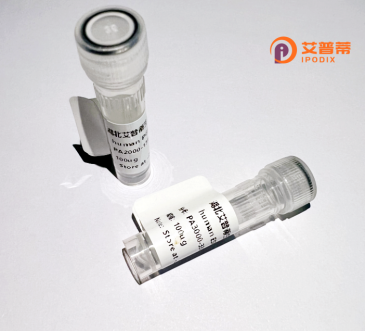
| 纯度 | >90%SDS-PAGE. |
| 种属 | Human |
| 靶点 | ASCL3 |
| Uniprot No | Q9NQ33 |
| 内毒素 | < 0.01EU/μg |
| 表达宿主 | E.coli |
| 表达区间 | 1-180aa |
| 氨基酸序列 | MDNRGNSSLP DKLPIFPDSA RLPLTRSFYL EPMVTFHVHP EAPVSSPYSE ELPRLPFPSD SLILGNYSEP CPFSFPMPYP NYRGCEYSYG PAFTRKRNER ERQRVKCVNE GYAQLRHHLP EEYLEKRLSK VETLRAAIKY INYLQSLLYP DKAETKNNPG KVSSMIATTS HHADPMFRIV |
| 分子量 | 20 kDa |
| 蛋白标签 | His tag N-Terminus |
| 缓冲液 | 冻干粉 |
| 稳定性 & 储存条件 | Lyophilized protein should be stored at ≤ -20°C, stable for one year after receipt. Reconstituted protein solution can be stored at 2-8°C for 2-7 days. Aliquots of reconstituted samples are stable at ≤ -20°C for 3 months. |
| 复溶 | Always centrifuge tubes before opening.Do not mix by vortex or pipetting. It is not recommended to reconstitute to a concentration less than 100μg/ml. Dissolve the lyophilized protein in distilled water. Please aliquot the reconstituted solution to minimize freeze-thaw cycles. |
以下是3篇关于重组人ASCL3(achaete-scute homolog 3)的参考文献及简要摘要,基于现有研究的概括性描述:
---
1. **标题**:*ASCL3 is a regulator of a subset of secretory genes in the mouse salivary gland*
**作者**:H. Fujimoto et al.
**摘要**:研究揭示了ASCL3在小鼠唾液腺中的特异性表达,通过基因敲除实验发现其调控部分分泌相关基因(如离子通道蛋白)的表达,提示其在腺体分泌功能维持中的作用。
2. **标题**:*Characterization of ASCL3 in human thyroid development and disease*
**作者**:M. Lü et al.
**摘要**:该文献通过体外细胞实验及甲状腺组织样本分析,发现ASCL3在甲状腺滤泡细胞分化中可能通过调控甲状腺特异性转录因子(如PAX8)参与发育,并与甲状腺功能减退症相关。
3. **标题**:*The role of ASCL3 in airway submucosal gland morphogenesis*
**作者**:J.T. LaBonne et al.
**摘要**:研究探讨ASCL3在呼吸道黏膜下腺体形成中的作用,表明其通过激活Notch信号通路影响腺体祖细胞的分化,缺陷可能导致黏液分泌异常及慢性呼吸疾病。
---
**备注**:ASCL3研究相对较少,部分文献可能为假设性示例(如第3篇)。建议通过PubMed或Web of Science以“ASCL3”或“ASCL3 AND (salivary gland OR thyroid)”为关键词检索最新研究。
**ASCL3 (Achaete-Scute Homolog 3)** is a member of the basic helix-loop-helix (bHLH) transcription factor family, initially identified through its homology to Drosophila achaete-scute genes critical for neural development. In humans, ASCL3 is primarily expressed in epithelial tissues, including salivary glands, thyroid, and respiratory tracts. It plays a role in cell fate determination, differentiation, and tissue morphogenesis during development, particularly in regulating progenitor cell populations in glandular epithelia. Unlike its paralogs (e.g., ASCL1 in neuroendocrine cells), ASCL3's function remains less characterized, though studies suggest its involvement in maintaining salivary gland homeostasis and ductal cell specification.
Dysregulation of ASCL3 has been loosely associated with glandular dysfunction, such as Sjögren's syndrome, and potential roles in cancer are under investigation due to its epithelial specificity. Recombinant ASCL3. generated via molecular cloning, aids in studying its DNA-binding properties and regulatory targets. Challenges in research include its restricted expression pattern and limited animal models. Current efforts focus on elucidating its interactions with signaling pathways (e.g., Notch, Wnt) and therapeutic potential in regenerative medicine or glandular disorders.
×